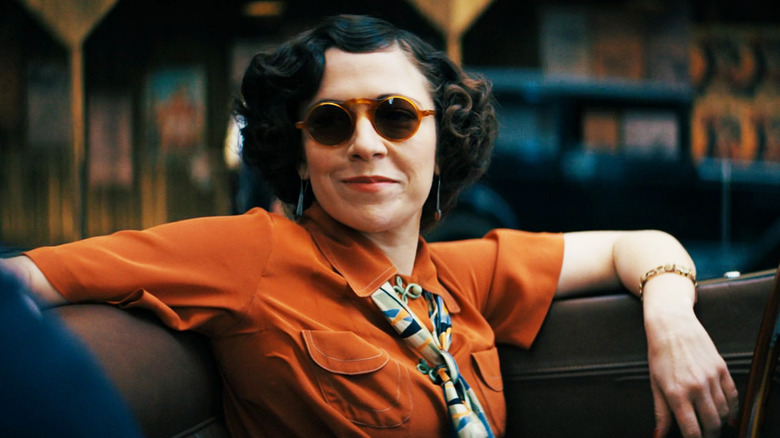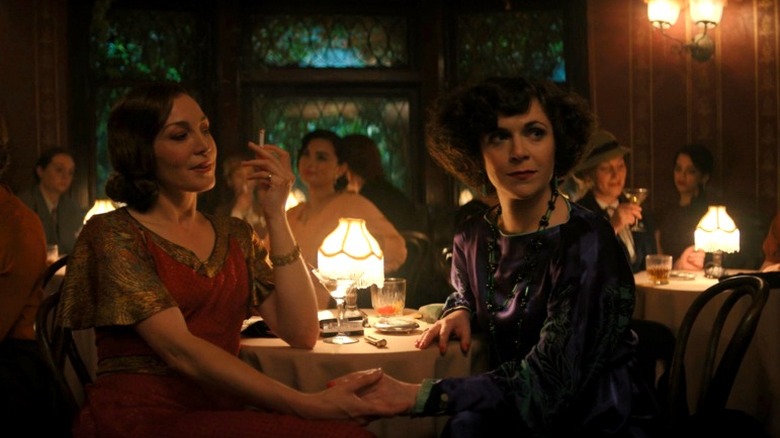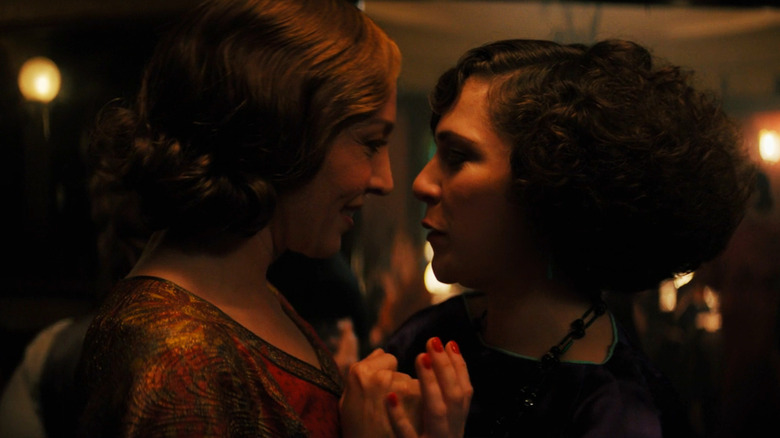Perry Mason's Anita St. Pierre Is Based On A Real-Life Hollywood Figure
This article contains spoilers for "Perry Mason" through season 2, episode 5, "Chapter Thirteen."
In its first season, HBO's pulpy, hardboiled version of "Perry Mason" introduced us to a version of Erle Stanley Gardner's famous criminal lawyer who had yet to become the formidable figure we know from previous iterations of the character. In this show, Mason is a war vet and private investigator who struggles with horrific memories of his wartime mercy killings, fights to keep hold of his family's farm, and reluctantly takes on the role of attorney after John Lithgow's E.B. Jonathan takes his own life. It's all a bit grim, really.
But with season 2, "Perry Mason" has put supporting characters front and center. While the gritty, somber tone is still there, the violence has been toned down a bit, and there are some genuine moments of joy. Many of those moments come from Juliet Rylance's Della Street as she further embraces her sexuality, discovering a world of underground lesbian clubs and throwing herself into a whirlwind romance with new love interest: Jen Tullock's Anita St. Pierre.
A successful screenwriter, Anita sweeps Della off her feet early in the season, making for some touching moments as the couple manage to explore their attraction while navigating the harsh realities of lesbian life in 1930s Los Angeles. In episode 4, the couple sneak off to Anita's Palm Springs getaway, where they can finally be together without worrying about being caught and risking their livelihoods. Part of what's so delightful about watching this relationship blossom is that it feels real — as if you're getting a genuine glimpse at both the relief and the trepidation that must have come with embracing a queer relationship in a much more regressive era. That feeling of realism is helped, too, by the fact that Anita is based on a real figure from Hollywood history.
The two Anitas
Screenwriter and author Anita Loos has been described by The Guardian as one of Hollywood's "greatest wits, most popular characters, and one of its key storytellers" during the silent era. Best remembered for her 1925 novel "Gentlemen Prefer Blondes," Loos actually wrote more than 150 scripts over her 30-year career, and was one of the most prominent women in the film industry before all the behind-the-scenes jobs started going to men and the male gaze era emerged.
Loos' legacy as one of Hollywood's biggest behind-the-camera talents has endured since the early 20th century, to the extent that even the "Perry Mason" writers based much of Anita St. Pierre on the prolific writer. Jen Tullock, the actress who plays Anita St. Pierre, spoke about Loos' influences in a Daily Beast interview, specifically citing Loos as a "total badass" who "had to fight tremendously to work her way up," which involved having to "play a bit like one of the boys." And while there doesn't seem to be any historical record of Loos herself being a lesbian, her standing as one of Hollywood's most successful writers provided an interesting basis for Tullock's character.
According to Tullock, it wouldn't be all that surprising if Loos was secretly queer. Tullock says she read Loos' memoir, "A Girl Like I" to prepare for her role, and got "kind of a queer vibe" from it.
Perry Mason and its real-world inspirations
In season 1 of "Perry Mason," we learned about Della Street being a lesbian who's in the unusual position of being able to live with her girlfriend, Hazel Prystock (Molly Ephraim) in a time when queer relationships were not only treated with disdain by the wider public, but were actually illegal. With the arrival of Anita St. Pierre, whom Della meets in a powder room during the season 2 premiere, the stakes are raised as Della begins to explore her sexuality through her newfound love interest, risking her promising career as Perry Mason's (unofficial) co-council.
It's made for some uplifting yet tense moments thus far, with Anita being the perfect person to show Della a side of Los Angeles that's remained as hidden to her as her own sexuality has been hidden from the wider public. Basing Anita St. Pierre somewhat on Anita Loos allowed the writers to challenge Della, as the glamorous world inhabited by Tullock's character is both exciting and threatens to distract her from her studying to become a lawyer, break up her existing relationship, and, as we saw in episode 5, cause her sexuality to be used against her as she's tailed to a lesbian club by a mysterious pursuer.
Thus far, the show has demonstrated a real awareness of the real-world struggles that would have been faced by its characters, particularly in relation to Chris Chalk's Paul Drake, who's in the unenviable position of grappling with the widespread racist attitudes of 1930s LA. Using Anita Loos as inspiration for a character infuses the show with yet more historical authenticity, helping to not only make for a compelling show, but to heighten the sense that the real Los Angeles of the 1930s was an exciting but harsh and unforgiving place.


